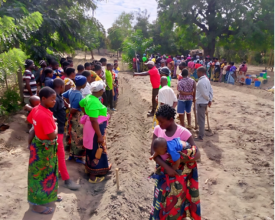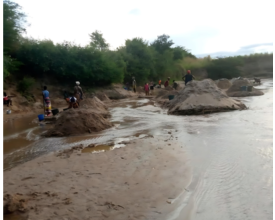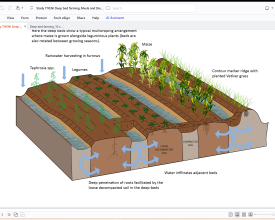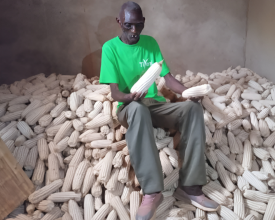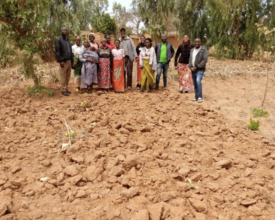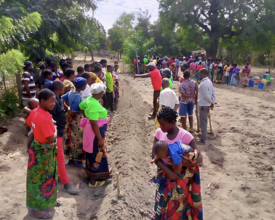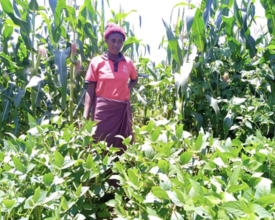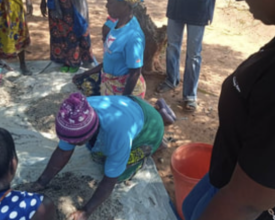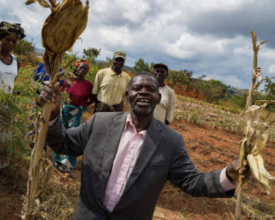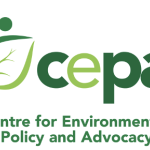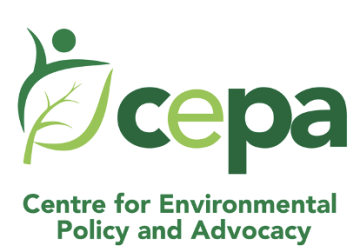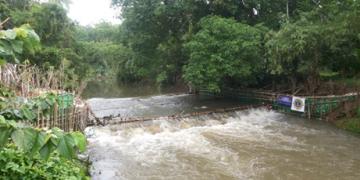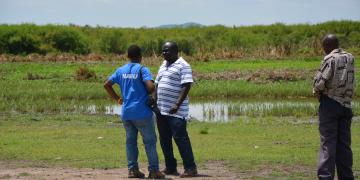
DEEP BED FARMING (DBF) FOR ENHANCED AGRICULTURAL LAND RESTORATION
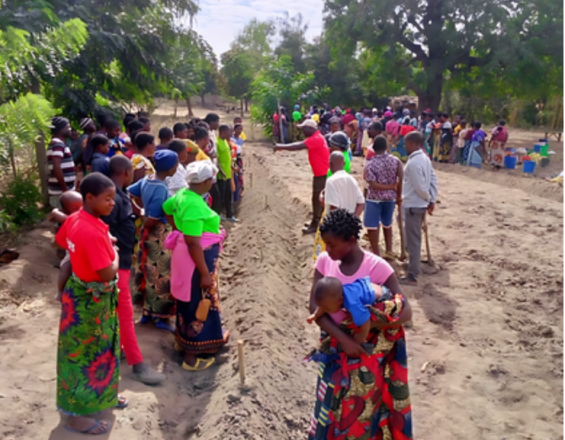
Tiyeni empowers Malawian farmers with Deep Bed Farming (DBF), a climate resilient method that boosts crop yields, improves water retention, and restores degraded soils, also known as Biointensive Gardening in other countries. By breaking the hardpan layer, DBF enhances soil fertility, reducing erosion and increasing food security. Since 2013, Tiyeni has trained over 15,000 farmers, with many achieving full food security and seeing a nearly ninefold profitability increase in their first year. The approach is sustainable, using a peer-to-peer model, whereby Lead Farmers train others, ensuring long-term adoption. This decentralized system strengthens communities and supports environmental restoration. Farmers who embrace DBF witness healthier soils and more resilient farms, proving its effectiveness in tackling Malawi’s food and climate challenges. The demand for DBF is growing, as more farmers see its benefits and request training, making it a transformative solution for agricultural sustainability and land restoration.
Contexte
Challenges addressed
Deep Bed Farming tackles major global challenges: climate change, soil degradation, water scarcity, and multidimensional poverty. Conventional farming harms the environment, emits greenhouse gases, and damages soils, making it harder for smallholder farmers to grow food sustainably. Soil compaction blocks water, air, and root growth, worsening drought and hunger. Deep Bed Farming restores soil health, boosts biodiversity, and captures over 90% of rainfall through simple, low-cost methods. It increases yields, reduces the need for costly inputs, and strengthens food security. By improving income, nutrition, and resilience, it helps lift communities out of poverty in multiple dimensions—economic, environmental, and social—making it a climate-smart and people-centered solution.
Emplacement
Traiter
Summary of the process
Deep Bed Farming is a practical, proven method where each step builds on the last to restore soil health, improve yields, and strengthen rural livelihoods. It begins by breaking the hardpan, allowing roots, air, and water to move freely through the soil—boosting plant strength and resilience to drought. This enables the creation of Deep Beds that prevent re-compaction, reduce runoff, and increase water storage. Farmers then plant diverse crops using intercropping and rotation, which restore soil nutrients, reduce pests, and avoid the damage of repeated monocropping. Weeding, mulching, and composting return organic matter to the soil, cut input costs, and replace synthetic fertilizers. Tiyeni’s livestock pass-on program supports composting and builds community self-reliance. Together, these steps produce higher yields, better nutrition, and increased incomes—often within the first season. Deep Bed Farming is a grounded, farmer-led solution to land degradation and food insecurity.
Building Blocks
Step 1: Break the hardpan
Deep Bed Farming begins with the crucial step of using a pickaxe to break up the compacted soil or hardpan. Breaking the hardpan in and of itself delivers powerful benefits by allowing roots, water, and air to penetrate deeply into the soil. These benefits produce immediate effects towards curbing soil erosion, or even stopping it altogether, thereby allowing rich healthy soils to start developing. Crops with deeper roots tend to be stronger. They can also successfully deal with long periods of dry weather and drought, which have become increasingly common because of climate change. Now able to penetrate the soil further, the deeper roots can also store much larger quantities of water for longer periods of time. Greater water storage enables roots to nourish crops far into the dry season.
This first step provides prompt, tangible benefits that are key to establishing credibility and raising enthusiasm for Tiyeni’s methods among farmers. The credibility and enthusiasm also build the momentum to interest farmers in additional aspects of Deep Bed Farming.
Step 2: Create Deep Beds
Next is the creation of the Deep Beds. These beds are designed to minimise water runoff, to maximise water retention, and to prevent a new compacted layer of soil from developing. With the soil hardpan broken, Deep Beds and the crops grown on them regenerate the land to allow roots, water, and air to penetrate into the soil indefinitely.
To prepare for the creation of Deep Beds, farmers make careful measurements to plan and then form marker ridges in harmony with the natural terrain. Each ridge has a ditch running alongside it, created with soil excavated when the ridges were formed. Ditches become holding reservoirs for rainwater and allow the water to slowly enter into the soil, helping to improve local water tables through a process called groundwater recharge. If the farmland is on a slope, the ditch is constructed uphill of the ridge so that it can serve as a dam for water after heavy rains. The ridge is then stabilised by planting vetiver. This non-invasive grass establishes deep root networks that contribute to sturdy soil structures, which also helps to mitigate erosion.
Now the farmers begin building the Deep Beds between the marker ridges! Deep Beds are designed to be larger than ridges used in conventional farming in Malawi. Each bed measures one metre wide, enough for two rows of maize or three rows of smaller crops. This wider bed enables a more agricultural land to be used for growing by creating a higher bed-to-ratio. Once created, the Deep Beds are never trodden on again, preventing re-compaction and the formation of a new hardpan.
Step 3: Plant diversified crops
Next, farmers plant their crops in the Deep Beds. Deep Bed Farming encourages farmers to move away from the monocropping that is practiced across much of Malawi. In monocropping, a single crop, in this case maize, is planted exclusively year after year on the same plots of land. Monocropping weakens the structure of the soil and depletes it of nutrients and leads to the growth of weeds and pests that are difficult to manage. To move away from monocropping, Deep Bed Farming diversifies crops through the application of intercropping and crop rotation.
Intercropping means that additional crops are planted alongside the staple crop of maize in the same season. These crops provide a natural ground cover that conserves soil moisture and also protects the land from the impact of large raindrops, which contributes to soil erosion. Crop rotation refers to changing the crops that are grown on a plot of land over the course of multiple seasons. In Deep Bed Farming, typical choices for intercropping include low-growing crops like pumpkins and ground nuts. For crop rotation, farmers will often rotate between legumes (e.g., beans) and cereals (e.g., maize).
Both intercropping and crop rotation regenerate the land, including undoing some of the damage caused by monocropping. Diversified crops restore depleted soil nutrients, increase soil fertility, improve soil structure and prevent erosion, and provide natural pest management. Together with the use of mulch and compost, this step enables farmers to transition away from the use of synthetic fertilisers.
Step 4: Weed, mulch, and compost
Weeds are often thought of as a nuisance, but in climate-smart agriculture they have a valuable role to play! Alongside the residue of crops and other plant materials, weeds are cut or pulled up and laid on top of the land as a form of mulch. Mulch is another type of ground cover that helps protect soil by minimising impacts of big raindrops and conserving moisture. Weeding is lighter work than digging, and whole families can help! Meanwhile, other organic materials like crop residues, leaves and grasses, and household food waste are made into a rich compost.
Farmers may also add animal manure to the compost. To make sure that all farmers have access to animal manure, Tiyeni organises a livestock pass-on programme of pigs or goats to first-time farmers. Animal offspring are passed on to other members of the community, contributing to Tiyeni’s legacy effect that ensures our work is self-sustaining in communities after our departure. Farmers’ interest in the successful breeding programmes brings village communities together and increases uptake of Tiyeni’s methods.
Mulch and compost add valuable organic matter to the soil that promote healthy soil microbiomes. They also enable farmers to transition away from synthetic fertilisers by providing the soil and plants with the necessary nutrients for healthy growth. Transitioning from synthetic fertiliser to mulch and compost also benefits farmers economically, as synthetic fertilisers are expensive. Plus, some of the methods that Tiyeni teaches to farmers can produce compost that is ready for use in as little as 21 days!
Step 5: Harvest!
When the harvest season comes, farmers using Deep Bed Farming benefit from crop yields that are more than doubled, starting from the very first year of adoption! Farmers have reported a ninefold increase in income in this first year as well. Healthier soil and diversified crops also provide more nutritious and balanced diets, helping to tackle malnutrition. Many Malawian farmers and their families have achieved food security through Deep Bed Farming, eating an average of one extra meal every day compared to their peers using conventional farming. Farmers continue to harvest these heightened crop yields year after year.
Impacts
Community outreach and self-empowerment
Tiyeni has reached over 37,000 farmers through its work to end food poverty and to improve water security. Our decentralized “train the trainer” model equips Lead Farmers with the skills to train their peers in Deep Bed Farming, giving its work an exponential legacy effect as each Tiyeni-trained Lead Farmer trains an average of 10-15 follower farmers a year.
Restoration of soil fertility and socioeconomic empowerment
Once the ‘hard pan’ is broken in a one-time digging with pickaxe, water as well as roots can penetrate beyond 30cm, allowing to harvest up to 90% of rainwater, 80% less runoff and 50% reduced soil erosion, which as well leads to greater access to nutrients. On average, crop yields were increased by 250%, whereby profits were 9-folded by excess crop production. By breaking the soil hardpan in a one-time step, smallholder farmers save a considerable amount of time, which they usually use for ploughing and weeding their fields.
Biological Diversification and Environmental benefits
Through intercropping, crop rotation, green manure and complementary planting, the soil always remains covered, and the space use is maximized. The use of mineral fertilizers can be gradually reduced and eliminated after a few years of implementing DBF. The increased biomass production enables compost making to further boost beneficial soil microorganisms, making plants more resilient.
Beneficiaries
At least 37,000 smallholder farmers were reached by DBF until 2024. Usually, a hub of Lead Farmers are trained who then teach the method to 10-15 fellow farmers each year.
Global Biodiversity Framework (GBF)
Sustainable Development Goals
Story
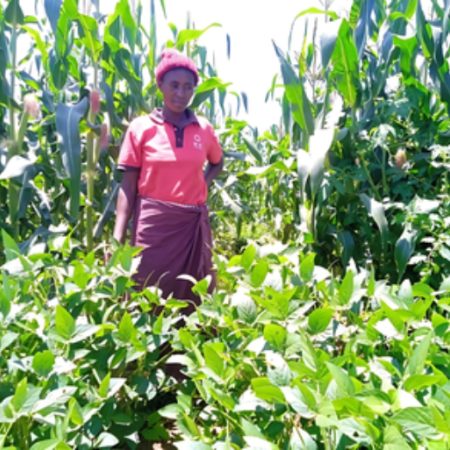
After the floods: Building farmers’ resilience to Cyclone Freddy
In 2023 Cyclone Freddy wreaked devastation on Malawi, hitting the country’s southern region twice. Climate change had increased the intensity of the cyclone and its effects, a trend that experts say will continue. After the cyclone had subsided, Tiyeni spoke with farmers in our southern hub in Mulanje to hear how Deep Bed Farming had built their resilience to this extreme weather event. Read what these farmers had to say below.
Crops under Deep Bed Farming were resilient in the floods, to the extent that my crops and beds were not washed away with the flooding. If I had not adopted Deep Bed Farming, I would not have survived the impact of Cyclone Freddy in terms of food. Even though the water was too much, I managed to harvest two and a half bags of maize from the [Deep] Beds.
Limited Ligomeka, Komwa village
______________________________________
Indeed those marker ridges and the raised beds withheld the pressure of water, because I could tell the difference between the [conventional] ridges and the [Deep] Beds. In the [conventional] ridges, soil erosion could be seen, and some ridges were washed away while the Deep Beds remained intact and just needed to be raised to their normal height.
Lusiwa Mangame, Mangame village

